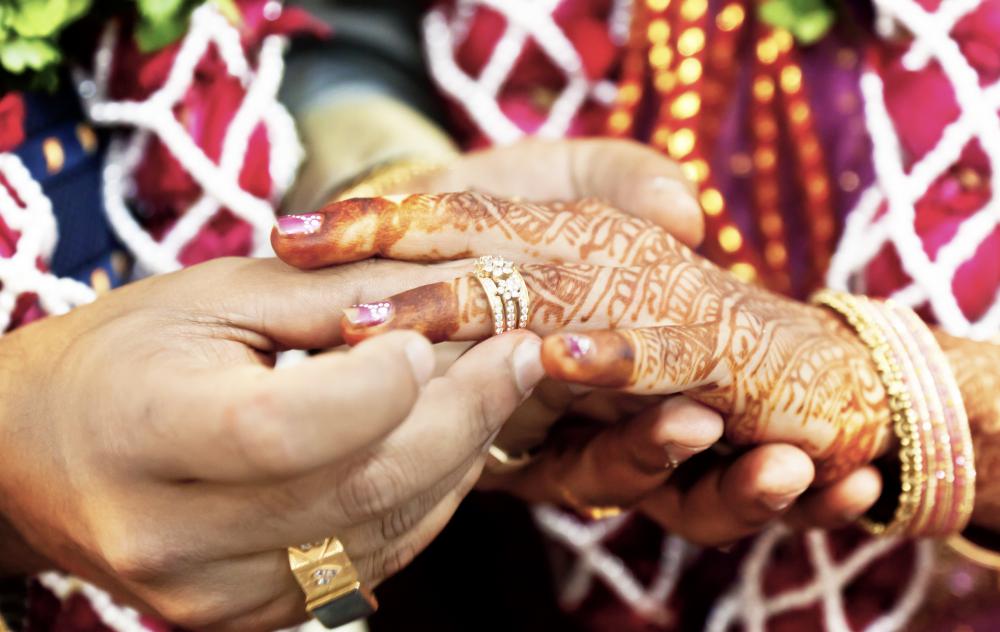At WiseGEEK, we're committed to delivering accurate, trustworthy information. Our expert-authored content is rigorously fact-checked and sourced from credible authorities. Discover how we uphold the highest standards in providing you with reliable knowledge.
What Are Dulhan Mehndi Designs?
Dulhan mehndi designs are temporary bridal tattoos that are applied to certain parts of a bride's body one or two days before her wedding. There are a few interesting traditions and beliefs surrounding dulhan mehndi designs, and a mehndi party is an important part of the dulhan mehndi tradition. Arabic and Pakistani designs are often popular choices for brides.
The bride usually has dulhan mehndi designs applied a few days before, or on the night of, her wedding. It is not only a form of decoration but also symbolizes happiness in marriage for the couple. Traditionally the hands and feet are covered in dulhan mehndi before the wedding, but the designs usually extend no further than the elbows or knees.

One of the beliefs surrounding dulhan mehndi designs is that the depth of color is an omen surrounding the marriage. A dark red color is highly desired, since this predicts a happy marriage for the couple. This may explain why dulhan mehndi is usually applied to the palms of the hands and soles of the feet, as the skin in these locations is much thicker and the color of the tattoo is usually darker in these than in other areas.

Another interesting belief is that the groom should search his bride's tattoos for his name or initials. If the groom does not find his name or initials, it is believed that the bride will be the one with the final say in the household. Traditionally the name or initials of the groom are inserted into the mehndi design somewhere on the bride's palms.

If the bride holds to tradition, the dulhan mehndi designs should be applied during a traditional mehndi party. Traditional parties are held during the week of the wedding and include only close female friends and relatives of the bride. In the past, it was considered an honor to be asked to attend a bridal mehndi party, as the members present would decorate the bride for her big day. In 2011, both men and women are invited to mehndi parties, which include music and dancing. A professional mehndi artist does the tattoos for the bride, her close female relatives, and friends.
Both Arabic and Pakistani designs are popular with brides and can be used as dulhan mehndi designs. Arabic mehndi designs are less intricate, and leave larger parts of the hands and feet unadorned. These tattoos usually include vines and leaves or floral patterns. Pakistani mehndi designs are very intricate and detailed and can take a long time to finish. These designs are also floral but cover most of the hands and feet.
AS FEATURED ON:
AS FEATURED ON:













Discussion Comments
@SteamLouis-- I know what you mean. A relative had mehndi done the day before her marriage. She had to sit with it on for many hours and she couldn't touch anything. So we were feeding her and giving her water through a straw.
Do grooms get mehndi designs usually? Their designs are more masculine and simple right?
Bridal henna designs are very difficult. They are extremely detailed and intricate. In fact, I've heard that some brides have the henna artist hide the groom's name within the design in their palm. And there is a condition on the night of the marriage, that the groom must find his name in the design before the marriage is consummated. It take a while if it's a very detailed design. I think it's a very interesting tradition though.
Actually it's just the opposite. Mehndi is applied to the palms and soles of feet because the skin is thinner and holds the color better. But dulhan mehndi is applied beyond these areas. Most brides have mehndi applied up to their elbow and also past their ankles, one third of the way to their knee.
That's why it usually takes all day to finish a bride's mehndi and it's also a ceremony and celebration among the womenfolk. The bride's close female relatives also get mehndi designs.
I've heard that if the mehndi comes out a very dark color, it means that the groom loves the bride very much. Of course, this is just tradition. The color of the mehndi has to do with the freshness of the henna and how long it remains on the skin. And some people have arranged marriages, not love marriages. But it's a nice thought anyway since the mehndi is bound to come out quite dark if good quality henna is used.
Post your comments